by William Eric McFadden
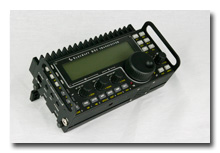 HF Field Equipment:
Although it doesn't see much time in the field anymore, my favorite HF field-portable
radio is still my Elecraft KX3 equipped with the internal automatic
antenna tuner and roofing filter modules, AK6Q SideKX panels and cover, VE7FMN Cooler
KX Lite heatsink, and N0WL PowerPole Adapter. The KX3's all-band coverage (160-6m),
all-mode (CW/SSB/AM/FM/data) capability, outstanding receiver performance, extremely
generous feature mix, small size, low weight, and battery-friendly design make the KX3
an extraordinary field-radio.
HF Field Equipment:
Although it doesn't see much time in the field anymore, my favorite HF field-portable
radio is still my Elecraft KX3 equipped with the internal automatic
antenna tuner and roofing filter modules, AK6Q SideKX panels and cover, VE7FMN Cooler
KX Lite heatsink, and N0WL PowerPole Adapter. The KX3's all-band coverage (160-6m),
all-mode (CW/SSB/AM/FM/data) capability, outstanding receiver performance, extremely
generous feature mix, small size, low weight, and battery-friendly design make the KX3
an extraordinary field-radio.
In order to encourage impromptu human-powered-transport field operations, I had put together a small and rugged (now retired) KX3 Travel Kit for high-performance bike/canoe/kayak field operations with the KX3. This has been replaced with the Enhanced KX3 Travel Kit for hiking and motor-vehicle-transport operations with the KX3 and the (now-retired) KX3 Mini Travel Kit for bicycle-portable operations.
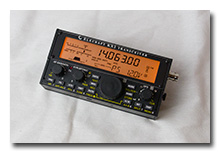 After nearly ten years of using my KX3 in the field, and wanting something smaller and
lighter than the KX3 for human-powered-transport field operations, I unexpectedly found
and then purchased an Elecraft KX2 that was being offered for a very
fair price from someone whom I trust implicitly. With performance nearly as high as that
of the KX3, the KX2 is so small it makes the small KX3 look big, it's very lightweight,
and it's perfect for operations where station weight and bulk is a concern. I've added
AK6Q SideKX panels to my KX2.
After nearly ten years of using my KX3 in the field, and wanting something smaller and
lighter than the KX3 for human-powered-transport field operations, I unexpectedly found
and then purchased an Elecraft KX2 that was being offered for a very
fair price from someone whom I trust implicitly. With performance nearly as high as that
of the KX3, the KX2 is so small it makes the small KX3 look big, it's very lightweight,
and it's perfect for operations where station weight and bulk is a concern. I've added
AK6Q SideKX panels to my KX2.
For bicycle-portable and pedestrian-portable operations, I have built the KX2 Mini Travel Kit.
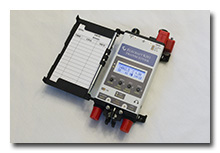 I was very much suprised to receive an Elecraft KH1 from my wife on
Christmas Day of 2023. The CW-only KH1 covers 40-15m; is absolutely tiny; weighs almost
nothing; includes an internal battery, an internal ATU, a built-in whip for 20, 17, and
15m, and a built-in CW paddle; and is optimized for HT-style pedestrian-mobile and
pedestrian-portable operations. I've improved the utility of the KH1 using several
products from Tufteln.
I was very much suprised to receive an Elecraft KH1 from my wife on
Christmas Day of 2023. The CW-only KH1 covers 40-15m; is absolutely tiny; weighs almost
nothing; includes an internal battery, an internal ATU, a built-in whip for 20, 17, and
15m, and a built-in CW paddle; and is optimized for HT-style pedestrian-mobile and
pedestrian-portable operations. I've improved the utility of the KH1 using several
products from Tufteln.
For bicycle-portable and pedestrian-portable operations, I have assembled the KH1 Micro Travel Kit.
In early 2024, I took delivery of a QRP Labs QMX 80-20m transceiver (info). This tiny 80/60/40/30/20m CW-and-digital transceiver will become the heart of a tiny QMX Micro Travel Kit which will be optimized for human-powered-transport field operations.
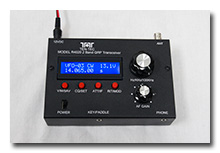 In late 2024, I found a Ten-Tec R4020, a small and rugged 40m and 20m
QRP trail-friendly transceiver with a surprising feature-mix for a price I couldn't pass up.
This radio can't compete with any of my Elecraft radios in terms of performance but it was
inexpensive enough I feel comfortable taking it into situations I wouldn't want to take my
higher-performance radios.
In late 2024, I found a Ten-Tec R4020, a small and rugged 40m and 20m
QRP trail-friendly transceiver with a surprising feature-mix for a price I couldn't pass up.
This radio can't compete with any of my Elecraft radios in terms of performance but it was
inexpensive enough I feel comfortable taking it into situations I wouldn't want to take my
higher-performance radios.
The R4020 and an LNR EF-10/20/40 Mark II QRP end-fed wire antenna form the core of the R4020 Mini Travel Kit, which lives in my car to enable me to engage in impromptu, unscheduled field operations wherever I happen to find myself.
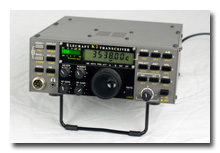 Prior to building my KX3, my favorite HF field-portable radio had been my Elecraft K2
with the SSB module, the 160-meters plus receive antenna module, the internal autotuner, the audio filter/clock
module, and the noise blanker module, an internal SLA battery, and the FingerDimple option. The K2's all-band
coverage (160m-10m), outstanding receiver performance, CW and SSB modes, generous feature-mix, relatively small
size and low weight, and battery-friendly design made the K2 a very good field-radio.
Prior to building my KX3, my favorite HF field-portable radio had been my Elecraft K2
with the SSB module, the 160-meters plus receive antenna module, the internal autotuner, the audio filter/clock
module, and the noise blanker module, an internal SLA battery, and the FingerDimple option. The K2's all-band
coverage (160m-10m), outstanding receiver performance, CW and SSB modes, generous feature-mix, relatively small
size and low weight, and battery-friendly design made the K2 a very good field-radio.
For motorized-transport field operations with the K2, I had built the (now-retired) K2 Travel Kit.
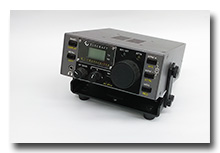 In late 2019, I unexpectedly acquired a very nice four-band (15/20/30/40m) Elecraft K1
transceiver with the internal automatic antenna tuner, noise blanker, and wide-range tilt
stand options. The K1's multi-band coverage, excellent receiver performance, small size
and low weight, and battery-friendly design make the K1 an excellent field radio.
In late 2019, I unexpectedly acquired a very nice four-band (15/20/30/40m) Elecraft K1
transceiver with the internal automatic antenna tuner, noise blanker, and wide-range tilt
stand options. The K1's multi-band coverage, excellent receiver performance, small size
and low weight, and battery-friendly design make the K1 an excellent field radio.
For pedestrian-portable and bicycle-portable operations, I had built the K1 Travel Kit. (Now that I have the KX2 and the KH1, The K1 doesn't see much field-use anymore.)
Prior to the purchase of my Elecraft KX3, I had a four-band Elecraft KX1 transceiver, a transceiver designed specifically for trail-friendly field operations. Unfortunately, this tiny transceiver and I just didn't get along well together and I eventually sold the KX1 to fund the purchase of my Elecraft KX3. I had put together a very small and very rugged KX1 Mini Travel Kit for bike/hike/canoe/kayak field operations with the KX1. (I now see the error of my ways and am actively looking for another KX1.)
 In late 2022, I purchased a used Yaesu FT-817ND transceiver. The FT-817ND is
a compact, full-feature, all-mode, QRP transceiver that covers 160m through 70cm. My FT-817ND is
equipped with
a W4RT Electronics 500Hz CW filter,
a FingerDimple FT-817 Kranker spinner-knob,
an N0WL Powerpole adapter,
and Portable Zero 817/818 Escort side-rails.
This transceiver is potentially more rugged than the Elecraft K1,
the Elecraft KX2, or the Elecraft KX3, and would certainly
cost less to replace than any of these Elecraft rigs if it were to be lost or damaged during an
outing.
In late 2022, I purchased a used Yaesu FT-817ND transceiver. The FT-817ND is
a compact, full-feature, all-mode, QRP transceiver that covers 160m through 70cm. My FT-817ND is
equipped with
a W4RT Electronics 500Hz CW filter,
a FingerDimple FT-817 Kranker spinner-knob,
an N0WL Powerpole adapter,
and Portable Zero 817/818 Escort side-rails.
This transceiver is potentially more rugged than the Elecraft K1,
the Elecraft KX2, or the Elecraft KX3, and would certainly
cost less to replace than any of these Elecraft rigs if it were to be lost or damaged during an
outing.
My FT-817ND serves as the heart of the FT-817 Travel Kit which is designed for picnic-table operations.
In late 2025, I acquired a used Wilderness Radio Sierra transceiver fitted with a 40m band module, a KC2 keyer/counter/meter module, and a BuzzNot noise blanker module. I'm awaiting delivery of a 20m band module. Once I've aligned the transceiver and band modules and have verified proper operation, I will build a Sierra Travel Kit for portable operations.
Before I purchased my Elecraft K2, my favorite HF field-portable rig had been an Index Labs QRP Plus. This rig was the heart of my QRP Station in a Bag. Unfortunately, I had to sell the QRP Plus in order to fund the purchase of the K2.
I have been experimenting with easy-to-deploy field-portable antennas.
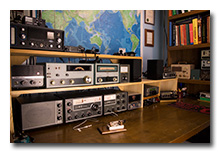 Home MF/HF Station:
The heart of my home MF/HF station (photo)
is the same Elecraft KX3 transceiver I enjoy using in the field.
The outstanding receiver performance and generous feature mix that make the KX3 such
a fine field-radio also make it a fine 'shack rig.
Home MF/HF Station:
The heart of my home MF/HF station (photo)
is the same Elecraft KX3 transceiver I enjoy using in the field.
The outstanding receiver performance and generous feature mix that make the KX3 such
a fine field-radio also make it a fine 'shack rig.
My primary back-up HF/MF rig is my Elecraft K2 transceiver. The K2, which was designed from the start to be an exceptional CW rig but also supports SSB and digital modes, has truly oustanding receiver performance.
My backup "high power" rig is a late-1980s-era ICOM IC-735 100-watt all-mode MF/HF transceiver with the optional 500Hz FL-32 CW filter. The IC-735 features a general-coverage receiver and is excellent for shortwave-broadcast listening. My IC-735 isn't completely healthy—output on all bands is only about 80 watts even after a full alignment and the ALC-metering circuit isn't working.
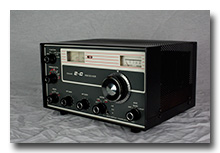 When I was a youngster, my father had a pair of stations featuring equipment made by the R.L. Drake
Company: first a TR-4 transceiver and then the well-regarded "Drake Twins", the R-4/T-4X separates.
Perhaps because of this, I've long been drawn to the black-and-gray tube-type HF equipment produced
by the Miamisburg, Ohio company. In 2016, I acquired my own version of the "Drake Twins": a
Drake 2-C receiver with the optional 2-AC internal crystal calibrator, a
Drake 2-CQ speaker / q-multiplier (thank you, Tom Czaja, KG9EE!), a Drake 2-NT CW transmitter,
and a Hallicrafters HA-5 VFO. This station quickly became my favorite to use for
casual CW rag-chew QSOs.
When I was a youngster, my father had a pair of stations featuring equipment made by the R.L. Drake
Company: first a TR-4 transceiver and then the well-regarded "Drake Twins", the R-4/T-4X separates.
Perhaps because of this, I've long been drawn to the black-and-gray tube-type HF equipment produced
by the Miamisburg, Ohio company. In 2016, I acquired my own version of the "Drake Twins": a
Drake 2-C receiver with the optional 2-AC internal crystal calibrator, a
Drake 2-CQ speaker / q-multiplier (thank you, Tom Czaja, KG9EE!), a Drake 2-NT CW transmitter,
and a Hallicrafters HA-5 VFO. This station quickly became my favorite to use for
casual CW rag-chew QSOs.
The 2-C receiver was offered by the R.L. Drake Company from 1966 through 1974 and is a vacuum tube (five) and semiconductor (fourteen) hybrid design which offered coverage of the pre-WARC amateur bands between 3 MHz and 30 MHz (80, 40, 20, 15, and 10m) in USB, LSB, CW, and AM modes and included four switchable receive bandwidths. I acquired my very clean 2-C at the 2016 Athens Hamfest. Thanks to KG9EE, I acquired a very pretty 2-CQ speaker / q-multiplier in late 2017 to use with my 2-C. I am seeking a 2-NB noise blanker module to use with my 2-C receiver.
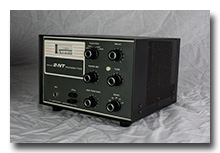 The Drake 2-NT transmitter was introduced by the R.L. Drake Company in 1966 for Novice licensees
and was a vacuum tube (three) and semiconductor (twelve) hybrid design which offered crystal-controlled
CW-only output on the pre-WARC amateur bands between 3 MHz and 30MHz (80, 40, 20, 15, and 10m). The
2-NT transmitter featured single-control tuning, adjustable-delay automatic T/R-switch, a sidetone oscillator,
and a "spot" function, making it easy for the well-heeled Novice licensee of the era to have a
fully-integrated, high-end Novice station. I acquired my clean 2-NT at Hamvention 2016. Just as a young
amateur of the period might have done following an upgrade from Novice, I use a Hallicrafters HA-5 VFO
with my 2-NT transmitter to allow variable transmit tuning. In addition, I have a very clean Hallicrafters HA-1 "T.O." Keyer
which I will eventually use with my 2-NT.
The Drake 2-NT transmitter was introduced by the R.L. Drake Company in 1966 for Novice licensees
and was a vacuum tube (three) and semiconductor (twelve) hybrid design which offered crystal-controlled
CW-only output on the pre-WARC amateur bands between 3 MHz and 30MHz (80, 40, 20, 15, and 10m). The
2-NT transmitter featured single-control tuning, adjustable-delay automatic T/R-switch, a sidetone oscillator,
and a "spot" function, making it easy for the well-heeled Novice licensee of the era to have a
fully-integrated, high-end Novice station. I acquired my clean 2-NT at Hamvention 2016. Just as a young
amateur of the period might have done following an upgrade from Novice, I use a Hallicrafters HA-5 VFO
with my 2-NT transmitter to allow variable transmit tuning. In addition, I have a very clean Hallicrafters HA-1 "T.O." Keyer
which I will eventually use with my 2-NT.
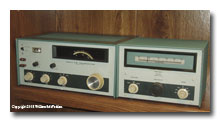 I have two Heathkit HW-16 transceivers and an HG-10B VFO.
The HW-16 was offered from 1967 through 1976 (source)
and was intended for Novice licensees who were at that time limited to 75 watts input and
crystal-controlled transmit, CW only, on 80, 40, and 15 meters. Essentially a separate transmitter and
receiver in one cabinet, the HW-16 is a vacuum tube, CW-only transceiver covering the bottom 250 kHz of
80, 40, and 15m with variable receive tuning and crystal-controlled transmit at up to 90 watts input. The
HW-16 features a 500Hz crystal filter, single-control transmitter tune-up, and full break-in (QSK)
operation. Just as a young amateur of the period might have done following an upgrade from Novice to
General, I've added a Heathkit HG-10B VFO to my HW-16 to allow variable transmit tuning.
I have two Heathkit HW-16 transceivers and an HG-10B VFO.
The HW-16 was offered from 1967 through 1976 (source)
and was intended for Novice licensees who were at that time limited to 75 watts input and
crystal-controlled transmit, CW only, on 80, 40, and 15 meters. Essentially a separate transmitter and
receiver in one cabinet, the HW-16 is a vacuum tube, CW-only transceiver covering the bottom 250 kHz of
80, 40, and 15m with variable receive tuning and crystal-controlled transmit at up to 90 watts input. The
HW-16 features a 500Hz crystal filter, single-control transmitter tune-up, and full break-in (QSK)
operation. Just as a young amateur of the period might have done following an upgrade from Novice to
General, I've added a Heathkit HG-10B VFO to my HW-16 to allow variable transmit tuning.
Prominent in the annals of QRP history are the three CW-only QRP kits Heathkit produced between the early seventies and the early nineties: the early two-tone-green direct-conversion HW-7 and HW-8, and the two-tone-brown super-heterodyne HW-9. I have one example of each of these classic transceivers.
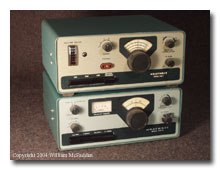 I have an HW-7, an HW-8, and the matching HWA-7-1 power supply
(photo). Not too many years ago, a common modification owners of the HW-7
and HW-8 transceivers performed was to install a crystal calibrator in these rigs to mark band edges.
Instead, I have installed a Small Wonder Labs Freq-Mite audible frequency counter (link)
in my HW-8. The Freq-Mite allows me to verify my frequency anywhere on the dial, not just at the band
edges. I have a vintage MFJ CWF-2 active audio CW filter (photo) to use
with these rigs; it provides bandwidths of 180, 110, and 80Hz. I use only manual keying devices—a
straight key or bug—with the HW-7 and HW-8.
I have an HW-7, an HW-8, and the matching HWA-7-1 power supply
(photo). Not too many years ago, a common modification owners of the HW-7
and HW-8 transceivers performed was to install a crystal calibrator in these rigs to mark band edges.
Instead, I have installed a Small Wonder Labs Freq-Mite audible frequency counter (link)
in my HW-8. The Freq-Mite allows me to verify my frequency anywhere on the dial, not just at the band
edges. I have a vintage MFJ CWF-2 active audio CW filter (photo) to use
with these rigs; it provides bandwidths of 180, 110, and 80Hz. I use only manual keying devices—a
straight key or bug—with the HW-7 and HW-8.
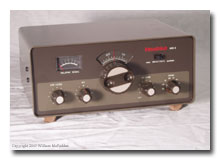 In early 2007, I acquired a very clean HW-9 with the WARC bands upgrade kit. The HW-9
is a much more sophisticated radio than either the HW-7 or HW-8. My HW-9 came to me with an SP-99 external
speaker into which a previous owner had installed a commercial open-frame 12v DC power supply. I also have
an Optimus XTS 3 woodgrain-and-black speaker that works well and looks good with the HW-9. I'm not entirely
satisfied with the performance of the receiver—strong signals outside the audio passband cause very
bad AGC pumping.
In early 2007, I acquired a very clean HW-9 with the WARC bands upgrade kit. The HW-9
is a much more sophisticated radio than either the HW-7 or HW-8. My HW-9 came to me with an SP-99 external
speaker into which a previous owner had installed a commercial open-frame 12v DC power supply. I also have
an Optimus XTS 3 woodgrain-and-black speaker that works well and looks good with the HW-9. I'm not entirely
satisfied with the performance of the receiver—strong signals outside the audio passband cause very
bad AGC pumping.
I owned an Argonaut 509 for a short while.
Prior to 1991, my hamshack featured vintage Yaesu gear.
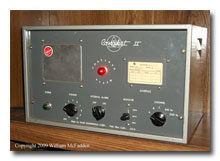 I have a deep fascination with Cold War era Civil Defense and I own an interesting piece of broadcast history, a
Kaar Engineering Conalert II monitor/receiver. This monitor/receiver was used by Ft. Wayne, Indiana's
WOWO to meet federal CONELRAD requirements early in the Cold War. The Conalert II is a five-channel
receiver, with two of the channels fixed on the CONELRAD frequencies of 640kc and 1240kc. (Visit
Rich Post's Boat Anchor Pix site
to learn more about the Conalert II and CONELRAD.) My Conalert II appears to behave differently than
Rich's—my unit's big, red "CONELRAD Warning" lamp triggers when a monitored carrier is lost but the
same lamp on Rich's receiver comes on when a carrier is detected. (Perhaps the Conalert II could
configured either way?) I've configured my Conalert II to allow me to listen to Athens' WOUB-AM and
Toronto's CFZM-AM. The latter station's "Sentimental Journeys" show is particularly rewarding to listen
to through this historic tube-type receiver. UPDATE: My Conalert II is now non-functional
due to a shorted power supply transformer; I don't have much hope for finding a replacement.
(I also have several other items of Cold War era Civil Defense history:
a CDV-717 Remote Gamma Survery Meter [photos: 1 | 2],
a CDV-742 Landsverk Dosimeter, yellow [photo], and
a CDV-742 Landsverk Dosimeter, gold [photo].)
I have a deep fascination with Cold War era Civil Defense and I own an interesting piece of broadcast history, a
Kaar Engineering Conalert II monitor/receiver. This monitor/receiver was used by Ft. Wayne, Indiana's
WOWO to meet federal CONELRAD requirements early in the Cold War. The Conalert II is a five-channel
receiver, with two of the channels fixed on the CONELRAD frequencies of 640kc and 1240kc. (Visit
Rich Post's Boat Anchor Pix site
to learn more about the Conalert II and CONELRAD.) My Conalert II appears to behave differently than
Rich's—my unit's big, red "CONELRAD Warning" lamp triggers when a monitored carrier is lost but the
same lamp on Rich's receiver comes on when a carrier is detected. (Perhaps the Conalert II could
configured either way?) I've configured my Conalert II to allow me to listen to Athens' WOUB-AM and
Toronto's CFZM-AM. The latter station's "Sentimental Journeys" show is particularly rewarding to listen
to through this historic tube-type receiver. UPDATE: My Conalert II is now non-functional
due to a shorted power supply transformer; I don't have much hope for finding a replacement.
(I also have several other items of Cold War era Civil Defense history:
a CDV-717 Remote Gamma Survery Meter [photos: 1 | 2],
a CDV-742 Landsverk Dosimeter, yellow [photo], and
a CDV-742 Landsverk Dosimeter, gold [photo].)
For HF digital modes with the Elecraft K2 or KX3, I have a Tigertronics SignaLink USB Interface (link | ARRL Review). The Elecraft KX3 and Elecraft KX2 natively do RTTY and PSK31 but I haven't tried using either rig for these modes yet.
My home station has emergency back-up power: a 30Ah Bioenno LiFePO4 battery is float-charged by a Bioenno 14.6v 4A A/C charger while the battery simultaneously powers my station's 13.8vdc loads. I will soon replace the A/C charger with a LiFePO4-specific solar charge controller and a 100w photovoltaic panel.
I use an Elecraft DL1 20-watt dummy load with RF detector (photo) to
accurately measure the power output of my low-power rigs. For quick use in the field, I have made up a
"look-up table" to simplify the process: DL1 Lookup Table (PDF).
CW Keys: I love CW and on MF/HF I operate CW almost exclusively. Over time I have accumulated a rather surprising number of CW keying devices:
- a pair of Speed-X model 310-001 oval-base straight keys;
- a U.S. military J-37 Mae West straight key;
- a pair of U.S. military J-47 machined-base straight keys;
- a U.S. military J-47 molded-base straight key;
- a U.S. military J-43 straight key;
- a pair of U.S. military J-41-A landline-telegraphy straight keys;
- a pair of U.S. military J-37 straight key, unmounted, one of which is by Winslow Electronics;
- a U.S. military J-45 "leg-clamp" key;
- a trio of U.S. military J-38 straight keys, one of which is by Lionel;
- a Key and Plug Assembly No. 9 key;
- a U.S. Navy CMH 26012A straight key;
- a British military W.T. 8 AMP. No. 2 MK III straight key;
- a Czechoslovakian military "Type RM31" straight key;
- a Western Union "Polechanger 1-B landline-telegraphy straight key;
- a Vibroplex Original Deluxe semi-automatic key;
- an E.F. Johnson Speed-X Model 114-520 semi-automatic key;
- a Vibroplex Vibrokeyer single-lever black-base keyer paddle;
- a pair of homebrew sideswipers;
- an HHC Cootie/Sideswiper;
- an American Morse Equipment Mini-B miniature single-lever keyer paddle;
- a Bencher BY-1 dual-lever keyer paddle;
- a Whiterook MK-22 straight key;
- a Whiterook MK-44 dual-lever keyer paddle;
- three Whiterook MK-33 single-lever keyer paddles; and
- an Autronic single-lever keyer paddle.
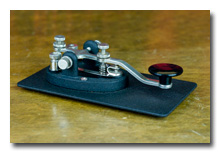 I acquired the older of my Speed-X model 310-001 straight keys (photo)
from an estate about the time I was first licensed and it is the key I used as a Novice in 1978; the key's
u-shaped sprung-anvil and "H15.682" markings on the bottom (photo) indicate
that the key is an early William M. Nye Company product.
I acquired the older of my Speed-X model 310-001 straight keys (photo)
from an estate about the time I was first licensed and it is the key I used as a Novice in 1978; the key's
u-shaped sprung-anvil and "H15.682" markings on the bottom (photo) indicate
that the key is an early William M. Nye Company product.
My second Speed-X model 310-001 straight key (photo) has a solid anvil and is a more recent William M. Nye piece; I am unable to remember when or from where I acquired this newer key.
I am a fan of the various military keys based on the J-37 key and have started to build a small collection of these keys. The J-37 feels good and works well and, in the words of K6IX, "J-37 keys are small, light, and tough as nails" (source). Of the many available J-37 variations, I have examples of the J-37 Mae West, the J-47, the J-41-A, the J-43, and the Key and Plug Assembly No. 9 key.
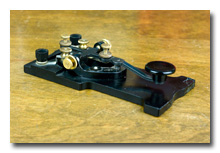 I restored my first U.S. military J-37 (photo) with a new-old-stock
vintage knob purchased from Artifax Books (link) and a J-37 Mae West
parts-key generously provided by Buddy Brown, N5BUD. A previous owner had cut the original machined bakelite base
but the remaining portion indicates the key is a non-Lionel J-47; the key is currently mounted on the Mae West
baseplate from the parts-key. (In military service, the J-37 key on the Mae West base was used exclusively
with the Code Training Set AN/GSC-T1A. The AN/GSC-T1A contained ten such J-37 keys; the Mae West base shape
allowed the cord to be wrapped around it for storage — sources: 1 | 2).
I restored my first U.S. military J-37 (photo) with a new-old-stock
vintage knob purchased from Artifax Books (link) and a J-37 Mae West
parts-key generously provided by Buddy Brown, N5BUD. A previous owner had cut the original machined bakelite base
but the remaining portion indicates the key is a non-Lionel J-47; the key is currently mounted on the Mae West
baseplate from the parts-key. (In military service, the J-37 key on the Mae West base was used exclusively
with the Code Training Set AN/GSC-T1A. The AN/GSC-T1A contained ten such J-37 keys; the Mae West base shape
allowed the cord to be wrapped around it for storage — sources: 1 | 2).
The U.S. military J-47 key is essentially a J-37 mounted on a simple bakelite base with four mounting holes and the marking "J-47"; the base was either machined bakelite with beveled edges and a white-stamped "J-47" marking or molded bakelite with a molded "J-47" marking (source). Research indicates the J-47 key was part the SCR-287 liaison radio system on WWII USAAF bombers and transport aircraft; however, there are also indications the J-47 was manufactured and used throughout the years of the Korean and Vietnam Wars, so I don't know the age of any of my J-47 keys.
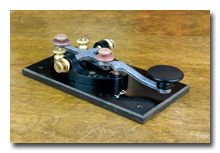 I have two machined-base J-47 keys. The first of my machined-base J-47 keys (photo)
needed a good cleaning and re-assembly consumed a screw and two binding-post knurled-nuts from the Mae West
J-37 parts-key mentioned above. The second of my machined-base J-47 keys is awaiting a thorough cleaning to
remove silver paint from the lever and other metal hardware applied by a previous owner.
I have two machined-base J-47 keys. The first of my machined-base J-47 keys (photo)
needed a good cleaning and re-assembly consumed a screw and two binding-post knurled-nuts from the Mae West
J-37 parts-key mentioned above. The second of my machined-base J-47 keys is awaiting a thorough cleaning to
remove silver paint from the lever and other metal hardware applied by a previous owner.
My molded-base J-47 (photo) came to me in very poor condition and, unfortunately, didn't clean up very well; re-assembly took one screw from the Mae West parts key. (Both of my J-47 keys were purchased together in December, 2012; they were each part of code-practice sets, very likely put together by an enterprising ham—or an aspiring ham—in the 1940s or '50s using war-surplus J-47s, buzzers, D-cell battery-holders, and pieces of heavy aluminum.)
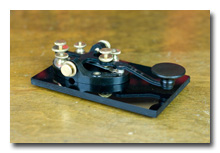 The U.S. military J-41-A key is essentially a J-37 key but in addition to the expected normally-open
contact, the J-41-A key has an additional normally-closed contact. In military-service the J-41-A was
used only for landline-telegraphy and was bolted to the lid of the Telegraph Set TG-5-B landline-telegraphy
unit. (The without-a-letter-suffix J-41 was installed in the TG-5 and TG-5-A; the J-41-A, with an improved
normally-closed contact, was installed in the TG-5-B — sources: 1 | 2).
Information about the TG-5 family of landline-telegraphy units can be found at
Morse Telegraph Club (link) and
PRC68.com (link).
Manuals for the TG-5 family are available at The Wireless Set No 19 Group (link);
look for TM 11-351.
The U.S. military J-41-A key is essentially a J-37 key but in addition to the expected normally-open
contact, the J-41-A key has an additional normally-closed contact. In military-service the J-41-A was
used only for landline-telegraphy and was bolted to the lid of the Telegraph Set TG-5-B landline-telegraphy
unit. (The without-a-letter-suffix J-41 was installed in the TG-5 and TG-5-A; the J-41-A, with an improved
normally-closed contact, was installed in the TG-5-B — sources: 1 | 2).
Information about the TG-5 family of landline-telegraphy units can be found at
Morse Telegraph Club (link) and
PRC68.com (link).
Manuals for the TG-5 family are available at The Wireless Set No 19 Group (link);
look for TM 11-351.
My first J-41-A came to me no longer mounted in a TG-5-B unit. In restoring this key (photos: 1 | 2), I used the lever from the aforemented J-37 Mae West parts-key and the key is mounted on a non-orignal base. This J-41-A is the best feeling of all my J-37 variants and is one of my favorite straight keys to use. My second J-41-A, a lovely-but-dusty example with black-anodized hardware, is still mounted in a mostly-complete TG-5-B and needs no restoration (photos: 1 | 2 | 3 | 4 | 5 | 6).
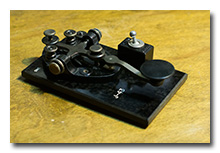 I purchased my J-43 straight key (photo) in the summer of 2017. As purchased,
the key was complete and in almost pristine condition; it is particulary lovely with black-anodized hardware
and needs no restoration. I am wondering if this J-43's open/closed toggle switch might be used to trigger a
T/R relay for use with transmitter/receiver separates.
I purchased my J-43 straight key (photo) in the summer of 2017. As purchased,
the key was complete and in almost pristine condition; it is particulary lovely with black-anodized hardware
and needs no restoration. I am wondering if this J-43's open/closed toggle switch might be used to trigger a
T/R relay for use with transmitter/receiver separates.
My pair of currently-unmounted J-37 keys were gifts from Jim Crouse, KC8OVB (SK), and were received shortly before Jim's death in February of 2019. The Winslow Electronics J-37 is very clean but has a hairline crack in the frame near the left-hand binding-post. This key should be OK if I can mount it rigidly on a base with three screws. The other J-37 is unmarked except for a "4" embossed in the right-front portion of the frame. The metal pieces of this key are brass colored. Unfortunately, a previous owner of this key scratched off the original "J-37" marking for some reason.
My J-45 leg-clamp key was purchased at the 2019 Athens Hamfest from the estate of KC8OVB (SK) and is in as-new condition, complete with original box and packing material but without a cable. The date-code on the box indicates this key was manufactured in 1983. The box is small enough there wouldn't be enough room for a heavy-duty cable, leading me to wonder if by the 1980s J-45 leg-clamp keys were shipped without cables and the cables were attached in the field.
The J-38 was designed to be used with a WWII Signal Corps radio/telegraph operator training set (source). I purchased my first J-38 straight key, a not-quite-complete example, at the 2015 Four Days in May adjunct to the Dayton Hamvention. I purchased my second J-38 straight key (photo), a complete and very pretty example, at the 2017 Hamvention.
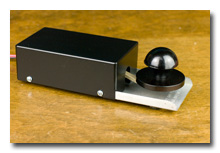 One variant of the British Key and Plug Assembly No. 9 key was made in the United States by the
Alden Products Company of Brockton, MA. It contained a version of the J-37 key and was part of the
Wireless Set No. 19 radio used heavily by the Canadian military during and after WWII (source).
The key was designed for mobile use and featured a pair of canvas straps to secure the key to the
operator's upper leg. The key had a European-style "mushroom" knob instead of the usual American flat
knob and the trunion lock-nuts had been moved inside the J-37 frame to allow the key to fit within the
narrow steel base and cover (source). The more common
variants of the Key and Plug Assembly No. 9 used the very narrow British "KEY W.T. 8 AMP."
key.
One variant of the British Key and Plug Assembly No. 9 key was made in the United States by the
Alden Products Company of Brockton, MA. It contained a version of the J-37 key and was part of the
Wireless Set No. 19 radio used heavily by the Canadian military during and after WWII (source).
The key was designed for mobile use and featured a pair of canvas straps to secure the key to the
operator's upper leg. The key had a European-style "mushroom" knob instead of the usual American flat
knob and the trunion lock-nuts had been moved inside the J-37 frame to allow the key to fit within the
narrow steel base and cover (source). The more common
variants of the Key and Plug Assembly No. 9 used the very narrow British "KEY W.T. 8 AMP."
key.
My Key and Plug Assembly No. 9 key came to me as part of a home-made code-practice set; the base and cover had been painted but the J-37 key itself was in very good condition and didn't even need serious cleaning (photos: stripped, ready for paint: 1 | 2 | 3; re-painted: 1). Interestingly, the J-37 key in my Key and Plug Assembly No. 9 contained not the usual one leaf spring but three such springs (photo). My key no longer has the canvas straps, the insulation is missing from the lever, and the exterior cover-screws are modern replacements.
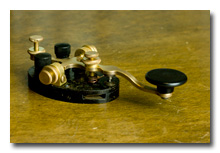 I acquired my Navy CMH 26012A (photo) in early 2012. This key is a WW2-era
key that appears to have been used with the NT-23146 "Single Key-Control Panel" (source).
The "CMH" code indicates it was manufactured by the American Radio Hardware Company (source).
The 26012A frame and terminals are bakelite and the lever is fully insulated. The left pivot-post is labeled
"GND" and has a screw so the lever can be connected to station ground. The left side of the frame contains a
slot for a bug wedge. The brass components of my 26012A brightened up nicely but the bakelite is showing signs
of discoloration. I need to find a suitable base upon which to mount this key. The knob on my key is a
made-in-Japan replacement; I will probably retain this knob but intend to replace its mounting screw with a
suitable setscrew.
I acquired my Navy CMH 26012A (photo) in early 2012. This key is a WW2-era
key that appears to have been used with the NT-23146 "Single Key-Control Panel" (source).
The "CMH" code indicates it was manufactured by the American Radio Hardware Company (source).
The 26012A frame and terminals are bakelite and the lever is fully insulated. The left pivot-post is labeled
"GND" and has a screw so the lever can be connected to station ground. The left side of the frame contains a
slot for a bug wedge. The brass components of my 26012A brightened up nicely but the bakelite is showing signs
of discoloration. I need to find a suitable base upon which to mount this key. The knob on my key is a
made-in-Japan replacement; I will probably retain this knob but intend to replace its mounting screw with a
suitable setscrew.
 I acquired my British "KEY W.T. 8 AMP. No.2 MK III" WW2-era key (code-name His Majesty's Key or HMK; photo) at the
2012 Dayton Hamvention. This key, marked "C.E.L. ZA 16929", is made of bakelite and came mounted on a nicely-crafted
non-original wooden base. According to W1TP, the W.T. 8 AMP was made in over 100 variations and was used widely
throughout WW2 (source). Unfortunately, the Key WT 8 Amp Worldwide Survey Results
book (link) doesn't identify who the manufacturer "C.E.L."
was or in what year this key was manufactured. Initially, after cleaning and reassembing this key, the lever was
too stiff in the pivot. I was unable to find any guidance online but eventually discovered that the small screw
directly above the pivot-pin isn't a lubrication point but appears to be, in fact, a drag adjustment; simply
backing this screw out a slight amount freed up the key's motion beautifully. Like my U.S. Military J-41-A keys,
the British W.T. 8 AMP. No.2 MK III has both normally-open and normally-closed contacts. This key is unique in my
experience in that it has two adjustments for the setting the gap. Both the front, normally-open, contact and the
rear, normally-closed, contact spacings are adjustable.
I acquired my British "KEY W.T. 8 AMP. No.2 MK III" WW2-era key (code-name His Majesty's Key or HMK; photo) at the
2012 Dayton Hamvention. This key, marked "C.E.L. ZA 16929", is made of bakelite and came mounted on a nicely-crafted
non-original wooden base. According to W1TP, the W.T. 8 AMP was made in over 100 variations and was used widely
throughout WW2 (source). Unfortunately, the Key WT 8 Amp Worldwide Survey Results
book (link) doesn't identify who the manufacturer "C.E.L."
was or in what year this key was manufactured. Initially, after cleaning and reassembing this key, the lever was
too stiff in the pivot. I was unable to find any guidance online but eventually discovered that the small screw
directly above the pivot-pin isn't a lubrication point but appears to be, in fact, a drag adjustment; simply
backing this screw out a slight amount freed up the key's motion beautifully. Like my U.S. Military J-41-A keys,
the British W.T. 8 AMP. No.2 MK III has both normally-open and normally-closed contacts. This key is unique in my
experience in that it has two adjustments for the setting the gap. Both the front, normally-open, contact and the
rear, normally-closed, contact spacings are adjustable.
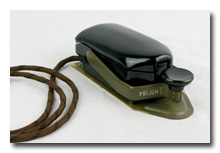 I purchased my nice Cold War-era Czechoslovakian military "Type RM31" straight key in January, 2015. This key
(code-name Radoslav; photos: 1 |
2 |
3 |
4 |
5)
appears to have been manufactured in the 1950s for the Czech armed forces and was part of an HF station
called the "Type RM31". My particular key was purchased in Germany by the fellow I purchased it from. The
original two-pin connector has been replaced by a 1/4" monaural jack but the key is otherwise in excellent
"collector-grade" condition. The key has a different feel than that of any of my other straight keys and is
fun to use. Information about the RM-31 key can be found here and here.
I purchased my nice Cold War-era Czechoslovakian military "Type RM31" straight key in January, 2015. This key
(code-name Radoslav; photos: 1 |
2 |
3 |
4 |
5)
appears to have been manufactured in the 1950s for the Czech armed forces and was part of an HF station
called the "Type RM31". My particular key was purchased in Germany by the fellow I purchased it from. The
original two-pin connector has been replaced by a 1/4" monaural jack but the key is otherwise in excellent
"collector-grade" condition. The key has a different feel than that of any of my other straight keys and is
fun to use. Information about the RM-31 key can be found here and here.
I purchased my Western Union "Polechanger Key B-1" from Steve Coe, K8SWH, in 2018. This key was manufactured by the Spies Electric Works of Chicago. The polechanger switch allowed the telegrapher to select one of three landline circuits to send on. Research has returned two widely different date ranges for the date of manufacture of this key. The National Museum of American History (link) states the key was manufactured circa 1890. M6BRN (link) claims that the Spies Electric Works was formed in 1899 and that the 1-B was manufactured between 1930 and 1940. With the possibility that key is nearly 130 years old, I kept clean-up limited, lightly cleaning only the bakelite base and leaving the majority of the metal pieces uncleaned. I would like to be able to use this key on the air but so far have been unable to restore continuity through the polechanger switch.
In the field, when keying mechanically, I use a Whiterook MK-22 Pocket Mini Telegraph Key (photo | link).
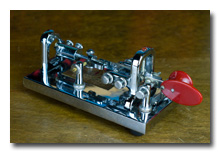 In early 2011, I purchased my Vibroplex Original Deluxe bug (code-name Fiddy; photo)
from Drew McDaniel, W8MHV. The serial number (214,744) indicates this key was manufactured in 1960. This bug
came to me with a nicely-homebrewed brass fixed dit-contact but I have since replaced this with the genuine
part. In a shorter time than I had expected I was able to learn how to send decent code with this
semi-automatic key and have been enjoying using it on the air. I get the best performance from this bug by
adjusting it as described in an excerpt from a WWII U.S. Army Signal Corps manual made available by N6TT
(link). I find I make far fewer sending mistakes with this
bug than I do with any of my electronic keyer paddles. In particular, I send the wrong number of dits far less
often with the bug than I do with a keyer. I speculate that the bug provides subtle mechanical-feedback to the
hand as dits are generated, feedback that a paddle and keyer lack. In order for my Elecraft KX3 (link)
to produce clean CW with this bug I initially placed a bit of foam in the u-shaped dot-spring and eventually
placed a capacitor across the bug's terminals.
In early 2011, I purchased my Vibroplex Original Deluxe bug (code-name Fiddy; photo)
from Drew McDaniel, W8MHV. The serial number (214,744) indicates this key was manufactured in 1960. This bug
came to me with a nicely-homebrewed brass fixed dit-contact but I have since replaced this with the genuine
part. In a shorter time than I had expected I was able to learn how to send decent code with this
semi-automatic key and have been enjoying using it on the air. I get the best performance from this bug by
adjusting it as described in an excerpt from a WWII U.S. Army Signal Corps manual made available by N6TT
(link). I find I make far fewer sending mistakes with this
bug than I do with any of my electronic keyer paddles. In particular, I send the wrong number of dits far less
often with the bug than I do with a keyer. I speculate that the bug provides subtle mechanical-feedback to the
hand as dits are generated, feedback that a paddle and keyer lack. In order for my Elecraft KX3 (link)
to produce clean CW with this bug I initially placed a bit of foam in the u-shaped dot-spring and eventually
placed a capacitor across the bug's terminals.
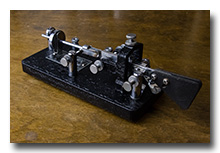 In 2018, I purchased an E.F. Johnson Speed-X model 114-520 semi-automatic key (code-name Effie) from
Steve Coe, K8SWH. E.F. Johnson Speed-X keys don't have serial numbers but my key has the older style fiber
"bulls eye" fingerpieces, the older-style nameplate, and the newer-style weight, which places its date of
manufacture between 1947 and 1953 (sources: 1 | 2).
The key was grimy at the time of purchase and had additional weight consisting of a stack of flat-washers and
duct-tape on the pendulum but the key cleaned up very nicely. After removal of the flat-washers and tape, a proper
adjustment per the WWI U.S. Army Signal Corps manual (link),
and despite a repaired-via-soldering u-shaped dot-spring, the bug works well. As with my Vibroplex Original Deluxe
bug (see above), in order for my Elecraft KX3 (link) to produce clean CW with this bug I have
placed a capacitor across the bug's terminals.
In 2018, I purchased an E.F. Johnson Speed-X model 114-520 semi-automatic key (code-name Effie) from
Steve Coe, K8SWH. E.F. Johnson Speed-X keys don't have serial numbers but my key has the older style fiber
"bulls eye" fingerpieces, the older-style nameplate, and the newer-style weight, which places its date of
manufacture between 1947 and 1953 (sources: 1 | 2).
The key was grimy at the time of purchase and had additional weight consisting of a stack of flat-washers and
duct-tape on the pendulum but the key cleaned up very nicely. After removal of the flat-washers and tape, a proper
adjustment per the WWI U.S. Army Signal Corps manual (link),
and despite a repaired-via-soldering u-shaped dot-spring, the bug works well. As with my Vibroplex Original Deluxe
bug (see above), in order for my Elecraft KX3 (link) to produce clean CW with this bug I have
placed a capacitor across the bug's terminals.
The Elecraft K2 and KX3 transceivers have excellent built-in memory keyers but when keying electronically at home I prefer to use my Idiom Press (link) CMOS Super Keyer II. I originally keyed iambically using a Bencher BY-1 paddle (photo | link) in the 'shack and a beautiful K8RA P-2jr with rosewood fingerpieces (photo | link) or lightweight Whiterook MK-44 Pocket Mini Iambic Paddle (photo | link) in the field. However, in 2011 I gave up on iambic keying and switched to single-lever paddles.
My speed with the dual-lever paddles and iambic keyer had seemed to peak at about 35 words-per-minute, and at that speed my accuracy wasn't nearly what it should have been. Research and a discussion with Pietro Begali, I2RTF, led me to conclude that I could gain accuracy if I were to forsake iambic (squeeze) keying in favor of non-iambic keying; I had absolutely no success in using any of my dual-lever paddles in non-iambic mode and determined to switch to single-lever paddles.
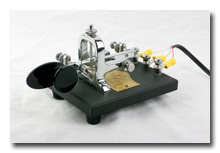 In February, 2015, I purchased a Vibroplex Vibrokeyer single-lever paddle (code-name Nora Noire; photo)
at the too-low-to-refuse price of $20 from the estate of KK8O. The Vibrokeyer's serial number
(107,405) indicates this black-base, non-jeweled, Vibrokeyer paddle was manufactured sometime
between 1995 and 2005 in Mobile, Alabama. A light dusting, and the replacement of a broken
thumb-piece ($7 from Vibroplex), and some tightening of screws was the only restoration this
key required. This Vibrokeyer paddle works very well and is now my primary keyer paddle for
use with an electronic keyer in the hamshack.
In February, 2015, I purchased a Vibroplex Vibrokeyer single-lever paddle (code-name Nora Noire; photo)
at the too-low-to-refuse price of $20 from the estate of KK8O. The Vibrokeyer's serial number
(107,405) indicates this black-base, non-jeweled, Vibrokeyer paddle was manufactured sometime
between 1995 and 2005 in Mobile, Alabama. A light dusting, and the replacement of a broken
thumb-piece ($7 from Vibroplex), and some tightening of screws was the only restoration this
key required. This Vibrokeyer paddle works very well and is now my primary keyer paddle for
use with an electronic keyer in the hamshack.
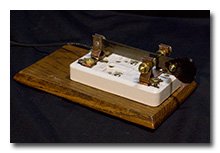 In mid-November, 2015, inspired by an article by W9LA (link),
I built a homebrew cootie-key / sideswiper (code-name Levon; photo)
as a ham in the 1930s might have done using a very old Leviton porcelain-base DPDT knife-switch from the estate
of Jim Mayer, W5XF (SK); an old hacksaw blade; some brass screws and nuts; and a pair of Fender guitar picks.
I have received reports of very clean keying while using this key. Somewhat surprisingly, this sideswiper
has become my overall-favorite key and is the key I use most often. Perhaps not surprisingly, five years of
using a bug followed by the adoption of a cootie-key / sideswiper absolutely destroyed my ability to
send well with an electronic keyer and I've had to work hard to recover my keyer-fist while still retaining my
bug-fist and my cootie-fist.
In mid-November, 2015, inspired by an article by W9LA (link),
I built a homebrew cootie-key / sideswiper (code-name Levon; photo)
as a ham in the 1930s might have done using a very old Leviton porcelain-base DPDT knife-switch from the estate
of Jim Mayer, W5XF (SK); an old hacksaw blade; some brass screws and nuts; and a pair of Fender guitar picks.
I have received reports of very clean keying while using this key. Somewhat surprisingly, this sideswiper
has become my overall-favorite key and is the key I use most often. Perhaps not surprisingly, five years of
using a bug followed by the adoption of a cootie-key / sideswiper absolutely destroyed my ability to
send well with an electronic keyer and I've had to work hard to recover my keyer-fist while still retaining my
bug-fist and my cootie-fist.
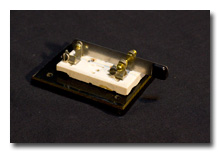 In late November, 2015, inspired by the success of my earlier project, I built a second 1930s-style
cootie-key / sideswiper (codename Midge; photo), this time using a
smaller vintage Leviton DPDT knife switch as the frame and a leaf from a feeler-gauge set as the lever. The
key is mounted on the fragment of J-47 machined-bakelite my first military J-37 came to me on. The key has
adjustable tension because I can swap out the lever with other feeler-gauge leaves of differing thickness. This
little sideswiper works very well and has the potential to become a favorite field-operations sideswiper.
In late November, 2015, inspired by the success of my earlier project, I built a second 1930s-style
cootie-key / sideswiper (codename Midge; photo), this time using a
smaller vintage Leviton DPDT knife switch as the frame and a leaf from a feeler-gauge set as the lever. The
key is mounted on the fragment of J-47 machined-bakelite my first military J-37 came to me on. The key has
adjustable tension because I can swap out the lever with other feeler-gauge leaves of differing thickness. This
little sideswiper works very well and has the potential to become a favorite field-operations sideswiper.
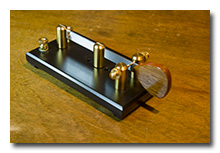 At the 2021 Findlay Hamfest I bought a gently used black, chrome, brass, and mahogony HHC sideswiper #046
(code-name Handsome Hank Cootie; photo). This key has an excellent, very smooth feel and is the
only sideswiper/cootie I have that has enough mass that I don't need to hold it with my left hand while I'm
keying with my right hand. This key operates so smoothly it may well become my favorite key. Internet
research on who made this HHC sideswiper reveals that these sideswipers are available on eBay from seller
Tennessee-based "ohrcw" (link). Internet
sources indicate that "ohrcw20" might be David Jones, K1KUZ, in Unicoi, Tennessee but I have not yet been able
to confirm this.
At the 2021 Findlay Hamfest I bought a gently used black, chrome, brass, and mahogony HHC sideswiper #046
(code-name Handsome Hank Cootie; photo). This key has an excellent, very smooth feel and is the
only sideswiper/cootie I have that has enough mass that I don't need to hold it with my left hand while I'm
keying with my right hand. This key operates so smoothly it may well become my favorite key. Internet
research on who made this HHC sideswiper reveals that these sideswipers are available on eBay from seller
Tennessee-based "ohrcw" (link). Internet
sources indicate that "ohrcw20" might be David Jones, K1KUZ, in Unicoi, Tennessee but I have not yet been able
to confirm this.
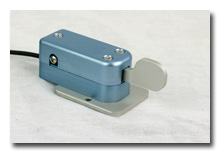 When keying electronically in the field I use a Whiterook MK-33 Mini Single Lever Paddle (photo | link)
or an American Morse Equipment Mini-B Miniature Single Lever Paddle (link).
For use in the hamshack, I can mount the Mini-B on the small-yet-heavy AME Porta-Paddle Base (photo | link).
My preferred field-paddle is the MK-33, and I usually use it as a cootie-key / sideswiper. I actually own three
examples of the MK-33: one is part of my Enhanced KX3 Travel Kit; one is
part of my K1 Travel Kit; and my original MK-33, which I purchased circa 2010, is
kept as a spare.
When keying electronically in the field I use a Whiterook MK-33 Mini Single Lever Paddle (photo | link)
or an American Morse Equipment Mini-B Miniature Single Lever Paddle (link).
For use in the hamshack, I can mount the Mini-B on the small-yet-heavy AME Porta-Paddle Base (photo | link).
My preferred field-paddle is the MK-33, and I usually use it as a cootie-key / sideswiper. I actually own three
examples of the MK-33: one is part of my Enhanced KX3 Travel Kit; one is
part of my K1 Travel Kit; and my original MK-33, which I purchased circa 2010, is
kept as a spare.
In June, 2011, I acquired an Autronic single-lever paddle (photo) from the estate of Jim Mayer, W5XF (SK). The Autronic paddle was manufactured from 1960 to 1968 by the Electrophysics Corporation (source). Mine is marked as having been made in Newport Beach, California, so it was made prior to the company's move to Costa Mesa in 1965. Unfortunately, it is missing one of the two barrel (double-taper) tension springs (photo); no exact replacement seems to be available and I am having trouble finding a suitable off-the-shelf replacement. Mike, K7MH, told me that suitable springs are occasionally offered by sellers on eBay, often with other key and paddle parts.
Home MF/HF Antenna Farm: My home MF/HF antenna farm is far from impressive. My primary HF antenna is a 135' windowline-fed dipole-doublet which I use on on all bands 80m through 10m by feeding it through a Johnson Viking 250-23 Matchbox balanced feedline antenna tuner. The doublet, which is suspended above the house at about 45' above the ground, is an excellent 80m Near Vertical Incidence Skywave (NVIS) antenna and it seems to work reasonably well for DX on the higher bands. With the windowline shorted and fed through the antenna tuner against ground, the antenna also works reasonably well as a compromise antenna on 160m. I monitor SWR with a Heathkit HM-9.
My primary DX antenna for the higher HF frequencies is a ground-mounted Hustler 6-BTV six-band (10, 15, 20, 30, 40, 80m) 1/4λ trap vertical with a DX Engineering radial base-plate (link), a DX Engineering Tilt Base (link), and a a DX Engineering 17-meter Add-On Kit (link). This antenna started as a 4-BTV (10, 15, 20, 40m) that I converted to a 6-BTV by adding 30m and 80m. I had no real interest in using this antenna for 80m but having the 80m resonator atop the antenna made the addition of 30m easier and I was able to find a no-cost 80m resonator locally.
The upgraded 4-BTV vertical antenna described above replaced a 5-band 5-BTV (10, 15, 20, 40, 80m) which was taken down by a tree blown over by a brief but intense wind-storm on July 1, 2012. This brief but intense wind-storm actually destroyed all three of my MF/HF antennas in one blow—the falling tree crushed the Hustler 5-BTV, dragged down the 135' doublet and a 195' Inverted-L 160m wire antenna, and severely bent the roof-mounted doublet support mast. I was able to install a new 23' mast on the roof and re-hang the 135' doublet on July 5, re-hang the Inverted-L on November 11, and install the new 4-BTV vertical on December 1, 2012. (The Inverted-L fell again in early January, 2013 and has not been replaced.)
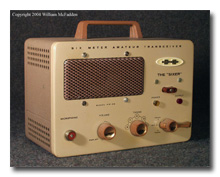 Home VHF Station:
I have a Heathkit HW-29 "Sixer" that I bought to use in the ACARA's weekly 6m AM
"boat-anchor" net. I started with a home-made vertical 6m dipole but now have a Cushcraft AR-6 Ringo.
Using the simple but effective Sixer has been fun, and I enjoy feeling the warmth of the chassis and
seeing the gentle glow from within the cabinet. (The collector in me wants to put together a complete
set of HW-30 "Twoer", HW-29A "Sixer", HW-19 "Tenner", and CB-1 Citizen's Band transceiver even though
I don't anticipate the desire or opportunity to operate 2m AM, 10m AM, or CB.)
Home VHF Station:
I have a Heathkit HW-29 "Sixer" that I bought to use in the ACARA's weekly 6m AM
"boat-anchor" net. I started with a home-made vertical 6m dipole but now have a Cushcraft AR-6 Ringo.
Using the simple but effective Sixer has been fun, and I enjoy feeling the warmth of the chassis and
seeing the gentle glow from within the cabinet. (The collector in me wants to put together a complete
set of HW-30 "Twoer", HW-29A "Sixer", HW-19 "Tenner", and CB-1 Citizen's Band transceiver even though
I don't anticipate the desire or opportunity to operate 2m AM, 10m AM, or CB.)
After continuing reports about low signal-strength from some participants of the ACARA's 6m AM net, I accepted from N8XWO the gift of a Gonset Communicator IV. The 15-watt output of the Communicator IV reaches quite a bit farther than the 2.5-watt output of the Sixer! Receive-tuning of the super-hetrodyne Communicator IV is much more critical than that of the super-regenerative receiver in the Sixer.
My Elecraft KX3 supports all-mode (CW/SSB/AM/FM/data) operation on 6m at up to 10-watts output. I have used the KX3 and MH3 mic to participate in the ACARA's 6m AM net and have received reports of good audio quality. I lack a good DX antenna for 6m and haven't yet tried operating the KX3 using "weak signal" modes on 6m.
For 2m FM in the hamshack, I use an ICOM IC-2200 fed into a Cushcraft 124WB Boomer four-element yagi mounted at about 25'. The yagi will soon be replaced by a Diamond X-300 2m/70cm omni-directional vertical.
Mobile/Portable VHF/UHF: For 2m/70cm FM/C4FM mobile operation I have a Yaesu FTM-100DR System Fusion transceiver in my car, a 2018 Honda Fit. The FTM-100DR's control head is mounted atop the dashboard and the RF deck is mounted in the front passenger footwell. (Originally, the control head was mounted on a Lido LM-300-18" seat-bolt-mount gooseneck but it quickly became apparent that the Fit is just too small and the control head kept getting bumped and knocked by front-seat passengers.) The antenna is a Diamond NR770HB dual-band ground-independent whip mounted on a Diamond HRKS mount installed on the Fit's driver-side rear "spaceship window".
My primary station for EMCOMM and support of public service events is my 2-Meter Go-Box which consists of an ICOM IC-V3500 65w 2m mobile transceiver, a 30Ahr Bioenno LiFePO4 battery, a fused PowerPole DC-distribution bus, and a DC power meter housed in a very rugged and completely waterproof Pelican 1450 case.
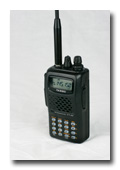 My main rigs for 2m/70cm FM pedestrian- and bicycle-mobile operation are a pair of Yaesu FT-60R
dual-band handhelds. I chose the FT-60R over competing models because the FT-60R has a dedicated
volume control (good for bicycle-mobile), offers AM-mode reception of civil aviation frequencies
(good for airshows), is rugged and weather-resistant, and is relatively inexpensive. I use a Diamond
SRH77CA dual-band whip antenna on each of these HTs. For 2m work "on the fringe", I use an MFJ-1714S
2m 1/2λ telescoping whip. I'm currently testing the performance of a Diamond SRH770S
(3/8λ on 2m; 3/4λ on 70cm) whippy-whip.
My main rigs for 2m/70cm FM pedestrian- and bicycle-mobile operation are a pair of Yaesu FT-60R
dual-band handhelds. I chose the FT-60R over competing models because the FT-60R has a dedicated
volume control (good for bicycle-mobile), offers AM-mode reception of civil aviation frequencies
(good for airshows), is rugged and weather-resistant, and is relatively inexpensive. I use a Diamond
SRH77CA dual-band whip antenna on each of these HTs. For 2m work "on the fringe", I use an MFJ-1714S
2m 1/2λ telescoping whip. I'm currently testing the performance of a Diamond SRH770S
(3/8λ on 2m; 3/4λ on 70cm) whippy-whip.
My secondary rigs for VHF/UHF portable operate are four Tid Radio TD-H3 handhelds and a Baofeng UV-5R handheld which are programmed for both Amateur Radio 2m/70cm and GMRS use. I use Diamond SRJ77CA 2m/70cm whip antennas on two of the TD-H3 handhelds and Tid Radio TD-771 2m/70cm whips on the other two HD-H3 handhelds and the UV-5R. These inexpensive Chinese handhelds are are currently the only VHF/UHF radios I own that support dual-receive. Because the TD-H3 features USB-C charging, two TD-H3 handhelds and two spare batteries remain in my car in an Underwater Kinetics #309 DryBox.
My tertiary rig for 2m/70cm portable operation is a Yaesu FT-70DR FM/C4FM System Fusion handheld, which I purchased when the Athens Couny Amateur Radio Association deployed DR-2X System Fusion repeaters on 2m and 70cm in the winter of 2019. The FT-70DR is considerably lighter than the FT-60R but the user-interface isn't as nice; in particular, it lacks a a dedicated volume control. I use a Diamond SRH77CA dual-band whip antenna on this HT.
I have a large and ancient two-channel, crystal-controlled Claricon VHF Handie Talkie VHF-100 (photo), a rig that was given to me when the previous owner wasn't able to sell it at the Athens hamfest and couldn't bear to consign the working rig to a dumpster. The VHF-100 is crystaled for the ACARA's 145.15 MHz repeater.
Portable APRS:
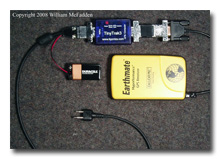 I have enjoyed playing with Automatic Packet Reporting
System (APRS) trackers for use in support of public service events such as the
Athens Marathon.
I have enjoyed playing with Automatic Packet Reporting
System (APRS) trackers for use in support of public service events such as the
Athens Marathon.
I have put together a 2m APRS tracker consisting of a Byonics TinyTrak3, a Byonics GST-1 Sentence Translator, a DeLorme Earthmate Serial GPS receiver, an Icom IC-2AT HT, and a 9.6v 1000mAh NiCD battery. For use of this tracking station on water or in inclement weather, the entire station fits within a water-proof Pelican #1200 case with gasketed BNC-feedthrough upon which a rubber duck, whippy 1/4λ, or 1/2λ extendable antenna can be mounted. (Read more about the APRS Tracker in a Pelican Case and my other work with APRS in Bicycle-Mobile Station.)
I tested but never finalized an APRS tracker using APRSdroid software (link), a retired Android smartphone, and a Baofeng UV-5R HT as described in the September, 2014 QST Hints and Kinks. The plan was to package this tracker in some sort of rugged, weather-tight case, but that never happened.
 Bicycle Mobile Operation:
I put together a Bicycle-Mobile Station for use during the ACARA's support
of the 2004 Athens (Ohio) Marathon. For that event, I rode with the marathon leaders with 2m FM voice
communication capability. Given the success of that venture, I added APRS to the station for the 2005 event
to provide real-time graphical display of the location of the marathon leaders. I have ridden bicycle-mobile
in support of the Athens Marathon every year since 2004 except when the event was canceled in
2020 and 2021 due to the COVID pandemic.
Bicycle Mobile Operation:
I put together a Bicycle-Mobile Station for use during the ACARA's support
of the 2004 Athens (Ohio) Marathon. For that event, I rode with the marathon leaders with 2m FM voice
communication capability. Given the success of that venture, I added APRS to the station for the 2005 event
to provide real-time graphical display of the location of the marathon leaders. I have ridden bicycle-mobile
in support of the Athens Marathon every year since 2004 except when the event was canceled in
2020 and 2021 due to the COVID pandemic.
I don't operate HF while riding the bicycle but do use the bicycle to transport myself and my equipment to HF field operations. I carried my QRP Station in a Bag in a backpack while bicycling, and I carried my K2 Travel Kit behind my bicycle in a trailer (FoBB 2010) and on my bicycle's rear rack (FoBB 2011). I developed the much smaller and lighter KX1 Mini Travel Kit to allow easier transport of ham radio on the bicycle (FoBB 2012 | 2013). After replacing the KX1 with a KX3, I built the KX3 Travel Kit to carry on the bicycle and later, after acquiring a K1 and then a KX2, I built the smaller, lighter K1 Travel Kit and KX2 Mini Travel Kit to carry on the bicycle. Currently, my favorite station for bicycle-portable operations is the absolutely tiny KH1 Micro Travel Kit.
Satellite Operation: I have an Elk 2M/440L5 dual-band log-periodic antenna (link) which I use with a Yaesu FT-60R dual-band hand-held to work through VHF/UHF FM satellites.
Until it prematurely fell apart, I had a Pryme AL-800 telescoping whip to allow monitoring of satellites while on walkabout; Pryme claims the following gain figures: 3.2dB 2m, 5.6dB on 70cm.
At Hamvention 2019, I purchased an Arrow II Model 146/437-10BP dual-band yagi (link) for FM satellite work. The Arrow II has three elements for 2m and seven elements for 70cm on a common boom and has separate feedpoints for each of these antennas, allowing two radios to be connected simultaneously. I have also purchased a Mini-Circuits BLP-200+ DC-to-190 MHz low pass filter for the 2m side of the yagi. The Arrow II and two FT-60R HTs will, I hope, allow me to hear myself on the satellite downlink frequency, which should lead to greater success in making FM satellite QSOs.
Since I already have an FT-817ND HF/VHF/UHF transceiver, I'm considering the purchase of a second FT-817 or an FT-818 to use for working through linear-transponder birds.
Note to self: The out-of-production ICOM IC-W32A allows full-duplex cross-band operation.
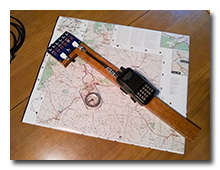 Foxhunting: In 2020, due to the efforts of Kirk Groeneveld, KC8JRV,
the ACARA began a series of monthly 2m foxhunts, and I've enjoyed participating in these events.
Foxhunting: In 2020, due to the efforts of Kirk Groeneveld, KC8JRV,
the ACARA began a series of monthly 2m foxhunts, and I've enjoyed participating in these events.
My foxhunt station consists of my FT-60R handheld transceivers, a Pacific Antennas 41dB switched attenuator (photo | link), my Arrow II Model 146/437-10BP yagi configured only for 2m, and a Handi-Finder TDOA DF antenna (link) currently configured as a bowtie. In the car, while driving between locations to take directional readings, I use my mobile transceiver and a second HT to monitor both the local repeater and the fox frequency.